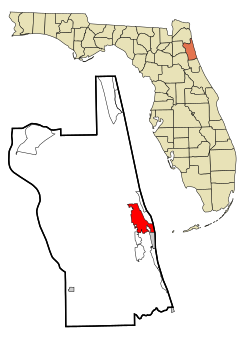Saint Augustine, Florida
|
St. Augustine San Agustín (Spanish) |
||
|---|---|---|
| City | ||
| City of St. Augustine | ||

Top, left to right: Castillo de San Marcos, St. Augustine Light, Flagler College, Lightner Museum, statue near the Cathedral Basilica of St. Augustine, St. Augustine Alligator Farm Zoological Park, Old St. Johns County Jail
|
||
|
||
| Nickname(s): Ancient City, Old City | ||
 Location in St. Johns County and the U.S. state of Florida |
||
| St. Augustine | ||
| Coordinates: 29°53′41″N 81°18′52″W / 29.89472°N 81.31444°WCoordinates: 29°53′41″N 81°18′52″W / 29.89472°N 81.31444°W | ||
| Country | ||
| State |
|
|
| County |
|
|
| Established | September 1565, 452 years ago |
|
| Founded by | Pedro Menéndez de Avilés | |
| Named for | Saint Augustine of Hippo | |
| Government | ||
| • Type | Commission–Manager | |
| • Mayor | Nancy Shaver | |
| Area | ||
| • City | 12.7 sq mi (33 km2) | |
| • Land | 9.4 sq mi (24 km2) | |
| • Water | 3.3 sq mi (9 km2) | |
| Elevation | 0 ft (0 m) | |
| Population (2010) | ||
| • City | 12,975 | |
| • Estimate (2013) | 13,679 | |
| • Density | 1,376.2/sq mi (531.4/km2) | |
| • Urban | 69,173 (US: 399th) | |
| Time zone | EST (UTC-5) | |
| • Summer (DST) | EDT (UTC-4) | |
| ZIP code(s) | 32080, 32084, 32085, 32086, 32095, 32082, 32092 | |
| Area code(s) | 904 | |
| FIPS code | 12-62500 | |
| GNIS feature ID | 0308101 | |
| Website | City of St. Augustine | |
St. Augustine (Spanish: San Agustín) is a city in the southeastern United States, on the Atlantic coast in northeastern Florida. It is the oldest continuously occupied European-established settlement within the borders of the continental United States.
The county seat of St. Johns County, it is part of Florida's First Coast region and the Jacksonville metropolitan area. According to the 2010 census, the city population was 12,975. The United States Census Bureau's 2013 estimate of the city's population was 13,679, while the urban area had a population of 69,173 in 2012.
Saint Augustine was founded on September 8, 1565, by Spanish admiral Pedro Menéndez de Avilés, Florida's first governor. He named the settlement "San Agustín," as his ships bearing settlers, troops, and supplies from Spain had first sighted land in Florida eleven days earlier on August 28, the feast day of St. Augustine. The city served as the capital of Spanish Florida for over 200 years, and became the capital of British East Florida when the territory briefly changed hands between Spain and Britain.
Spain ceded Florida to the United States in 1819, and when the treaty was ratified in 1821, St. Augustine was designated the capital of the Florida Territory until Tallahassee was made the capital in 1824. Since the late 19th century, St. Augustine's distinct historical character has made the city a major tourist attraction, and it is also the headquarters for the Florida National Guard.
...
Wikipedia


